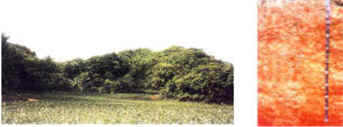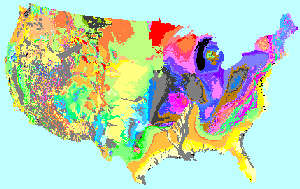BACKGROUND:
|

Puerto Rico
|
Students have compared the difference between the Moon and the Earth. A
major difference between the surface is the presence of soil on the Earth.
Soil is a mixture of organic material and very small mineral and rock
particles that can support rooted plant life.
The formation of soils is complex. Weathering of rock at the Earth’s
surface breaks down rocks into pieces, and chemically dissolves them into
different components. These weathering products form the inorganic
ingredients of soil. The organic ingredients of soil, such as plant debris
and animal waste, accumulate on the Earth’s surface.
Inorganic and organic components of soil mixed together in a variety of
ways. As water sinks through the ground, it transports decayed organic
material downward, where it mixes with weathered rock. Animals, like
earthworms and moles, help to mix these materials as they dig tunnels.
Soils are a unique consequence of life on Earth. Other planets,
particularly Mars, may have layers of weathered rock at their surfaces, but
only the Earth has soils. Soils are present everywhere on the Earth where
life is present or was present in the past. The specific type of soil that
forms in a given area depends on three main factors. These include: 1) the
type of rock available to be weathered, 2) the types of life in the area,
and 3) the climate (temperature and rainfall).
Soil can be described and classified into different groups by soil
scientists. Some classification are based on soil structure, color, organic
content, and climate setting. We use a very simplified classification based
on precipitation, to help students quickly identify and then plot the
information. We use only three basic groups including pedalfers, pedocals,
and laterites.
PEDALFERS - These soils are usually found in temperate areas that receive
more than 60 centimeters of rain each year. They are very fertile,
containing an abundance of aluminum and iron, and are a brown-black color.
Pedalfers are present in much of the eastern half of the United States and
most of Canada.
PEDOCALS - These soils are usually found in dry, warm climates such as
those of the western United States, that get less than 60 centimeters of
rain per year. The contain abundant calcium carbonate and many sulfate
minerals. They are characteristically a light gray-brown color.
LATERITES - Laterites occur in warm, tropical areas that get more than
120 centimeters of rain per year. They have a distinctive deep red color,
and contain much aluminum oxide and iron oxide. Oxidized iron gives laterite
its red color.

Different color represent different typed of rocks.
PROCEDURE:
This activity will have students discuss soil and how
we can plot the type of soil on a map to see if there are any reasons for the
pattern
- Ask the students to define soil. Many of them will
just say "dirt." Give them an accurate explanation of what
soil is, and how it forms. Make sure they realize that soil is a unique
consequence of life and rock on the Earth, and that it is present
throughout the world.
- Have the students locate themselves on the U.S.
Placemats. Explain that there are different rocks throughout the United
States. You may wish to point out areas of metamorphic, igneous, and
sedimentary rock. Impress on the students that since there are many
rocks on the surface of the United States (and the world) that there
will be many different soils as well.
- Define pedalfer, pedocal, and laterite soils for
the students. Use the simplified definition in the background
information.